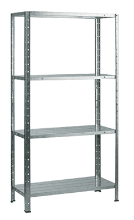Boltless Rack vs. Bolted Rack: Which is Best for Your Warehouse?
When optimizing your warehouse or home space, selecting the right racking is important. Two primary options stand out: boltless racks and bolted racks. Each racking shelves offers its own advantages and useful to specific storage needs. This guide will help to differentiate between these two types of racks to help you make an correct decision for your storage.
What is a Boltless Rack?
A boltless rack is a racking shelves that requires no bolts, nuts, or screws for assembly. Its innovative rivet-and-keyhole design ensures quick and easy install. This type of rack is renowned for its simplicity and versatility, making it an ideal choice for various storage applications.
What is a Bolted Rack?
In contrast, a bolted rack relies on traditional assembly methods, utilizing bolts, nuts, and screws to secure components. This construction often results in a more tough structure and feel secure, making bolted racks suitable for any storage requirements.

Key Differences Between Boltless and Bolted Racks
Let’s compare these two racking based on several crucial factors:
- Ease of Assembly
- Boltless Rack: Known for its user-friendly assembly process, a boltless can be set up swiftly without requiring any tools. This makes it a preferred option for businesses that frequently need to adjust their storage layout.
- Bolted Rack: Assembly of a bolted rack is more time-consuming due to the involvement of bolts and nuts. While it demands additional effort, the resulting structure tends to be more stable and secure.
- Flexibility and Adjustability
- Boltless Rack: Offering exceptional flexibility, boltless allow for effortless shelf repositioning to accommodate items of different sizes. This adaptability is particularly beneficial for a space with fluctuating inventory levels.
- Bolted Rack: While adjustable, modifying a bolted rack is less convenient compared to its boltless counterpart. Adjusting shelves involves loosening and tightening bolts, which can be time-consuming. However, once configured, the setup tends to be more stable.
- Durability and Stability
- Boltless Rack: Boltless racks provide adequate durability and stability for most light to medium-duty storage applications. However, for extremely heavy loads, a bolted rack might offer superior stability.
- Bolted Rack: Renowned for its durability and stability, a bolted rack is engineered to handle heavy-duty storage and industrial environments due to its secure tight framework.
- Cost Considerations
- Boltless Rack: Generally, boltless are more cost-effective in terms of both initial purchase and labor costs associated with assembly. The ease of setup can lead to significant savings.
- Bolted Rack: While upfront costs and labor expenses might be higher for bolted racks, their superior durability and load-bearing capacity often justify the investment in the long run.
Which Racking System is Right for You?
The optimal choice between a boltless rack and a bolted rack hinges on your specific warehouse needs and priorities. Consider the following factors:
- Storage requirements: Determine the weight and size of the items you plan to store.
- Frequency of layout changes: Evaluate how often you anticipate modifying your storage configuration.
- Budget: Assess your financial constraints to determine the most suitable investment.
For light to medium-duty storage with frequent layout adjustments, a boltless rack is often the ideal choice. Conversely, if you require a heavy-duty, long-lasting solution, a bolted rack might be more suitable.
Conclusion
Both boltless and bolted racks offer valuable storage solutions. By carefully considering your warehouse’s unique requirements, you can select the system that maximizes efficiency and productivity. Click here for Hyperack Best Seller Boltless Rack Specification
? Follow us on Facebook | Tiktok | LinkedIn | Youtube


